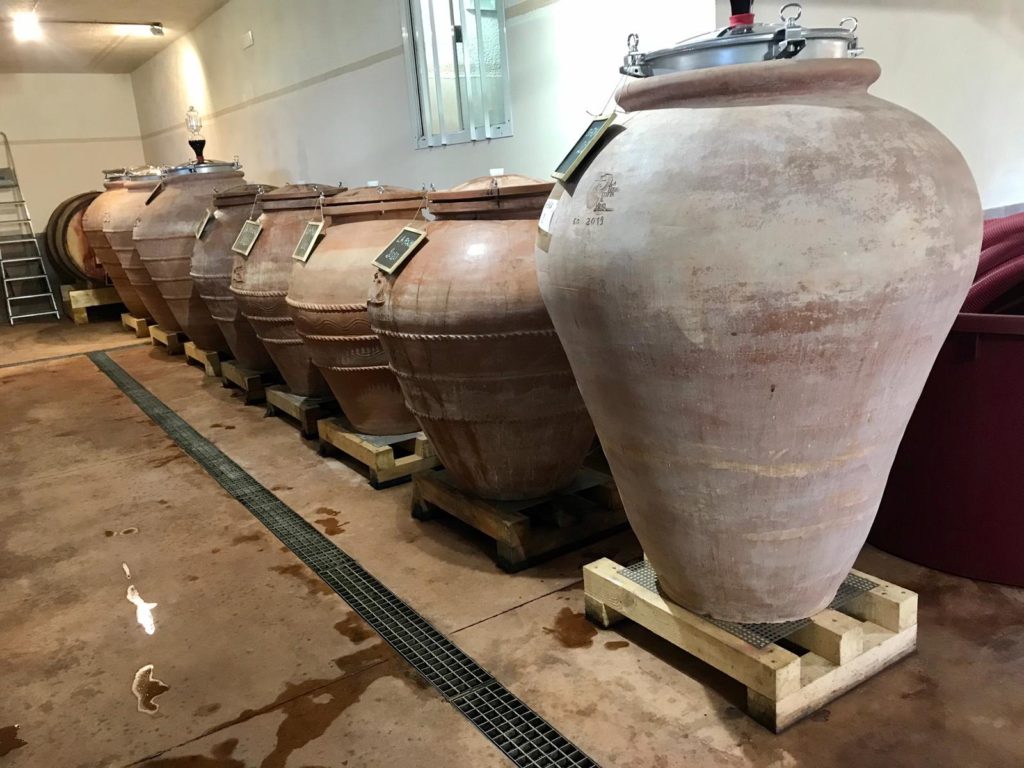Why You’ll Love Terre Antiche
Piglio: The Cradle of Cesanese Wine
The cradle of Cesanese wine is a medieval village that seems to cling with its nails to a rocky spur of Monte Scalambra. The roofs of its ancient houses, built around the great Castle, follow one another irregularly and seen from above they look like waves of tiles whipped by the breeze. Around the town, the orderly vineyards and the wild nature compete with each other, still marking the natural rhythms of life today. Good wine, fresh and light air, Ciociaria cuisine at its best: nothing here could be better than it is.
Anagni: City of the Popes, Passerina, and Poetry
Anagni is a vision, placidly lying on the hill overlooking the valley. Today it is a chest full of medieval treasures, but its history begins much earlier, since it was first Hernian and then Roman. City of the Popes, they call it. And rightly so, because in the 13th century, under the lordship of the Caetanis, it gave birth to four popes, becoming a splendid papal residence and even hosting Dante Alighieri. The cathedral and its museum, the Palazzo della Ragione, the access doors, the narrow streets of the historic centre, the Palazzo di Bonifacio VIII (the pope of the slap) with the annexed Bonifacio Museum: everything here seems to have come out of a fairy tale . Yet it is all so extraordinarily real and concrete.
Single Vineyard Cru Of Ancient Roman Wines
The vineyards of the Terre Antiche Estate are found in the municipalities of Piglio and Anagni, at a height of about 1,000 feet above sea level. They are located at the foot of the Ernici Mountains, in an uncontaminated natural environment.
Their story stems from a common dream, shared by Ambrogio, Tonino and Michele; three friends with one mission: enclosing an ancient world in a bottle of wine. An excellent quality wine, capable of expressing an entire cultural and territorial philosophy.
After meticulously choosing lands of absolute agronomic value and superbly exposed, all coming from pure clones of Cesanese di Piglio and Affile planted in the 60s and 80s. This mix of vineyards divided into several parcels gave rise to the idea of directing the production of wines directly to “single cru”; therefore wines from specific vineyards, arranged on very different terrains in terms of conformation and exposure, so that the final products could best represent the pure expression of each individual vineyard.
From the subsequent meeting with the enologist Michele Lorenzetti, the idea was born to aim for a perfect harmony between nature, agriculture and people, through the choice to follow the path of biodynamic farming from the first day.
Cesanese del Piglio
Cesanese del Piglio is a type of red berried DOCG wine produced in the municipalities of Piglio, Serrone, Acuto, Anagni and Paliano in the province of Frosinone. The oenological heart of this enchanted corner of the earth is Piglio, an extremely ancient village whose name would seem to derive from the pileum, a helmet of Roman origin. Here the vines have always been cultivated, in perfect harmony with peasant culture and nature.
This is an idyllic territory, where every hill is dotted with the old tiled roofs of the perched villages and towns. A few kilometers from Piglio is Anagni, a medieval pearl with a superb cathedral. Smoking chimneys, crenellated walls, arcane stone churches: everything here brings us back to a noble and glorious past, which has spanned the centuries to arrive intact before our enchanted eyes.
Here, Italian wine excellence knows how to explode in all its fascinating power. The estate wants to spearhead this movement, through a vision of merging ancient knowledge and new operating methodologies.
Their estate cellar seems like a treasure chest, which contains knowledge, flavors, and experiences. Within these walls, through constant and painstaking work, the grapes become nectar.
Biodynamic Farming
Biodynamic cultivation was chosen from the outset as the agronomic method, with the aim of outlining the distinctive features of quality in our wines. It builds a virtuous relationship between soil and plant.
Soil is an ecosystem where thousands of different microorganisms coexist, all involved in maintaining the biological structure and in the conservation of organic matter and humus. This vitality is the very secret of quality.
The vine grows in the best possible place and consequently expresses itself to its fullest, accumulating all the components in the grapes that you’ll find in the glass.
To achieve this, they work with Carlo Noro’s biodynamic preparations and take advantage of the experience of their oenologist Michele Lorenzetti. The preparations, through their correct use, ensure the maintenance of the vital organization of the soil and represent the basis of the qualitative path. The grapes that are born through this harmonious relationship between soil and plant will have everything it takes to ferment correctly and spontaneously. In this way, their wines will not need any additives, except very low quantities of sulfur that are added a few weeks before bottling.
Aging Wine in Amphora, Cement, and Chestnut Barrels
Unique in the area, the estate uses terracotta clay amphora for Passerina and for some portions of Cesanese. These particular containers ensure a prompt evolution of the wine, through an excellent relationship with oxygen during the 8 months in the amphora. The use of amphorae for wine has very ancient origins, and this kind of container represents the first container in which wine was produced, 8000 years ago. A connection with the story of wine that they wanted to harness and continue. Because to look to the future, one must always first look back.
Their best Cesanese is aged in large capacity native chestnut barrels. The wine they produce must have the flavors and scents of our lands, it must speak of identity and tradition. Their best grape selections are refined not only in amphorae, but also in chestnuts and cements which ensure that the characteristics of these grapes are kept clear and sharp.






